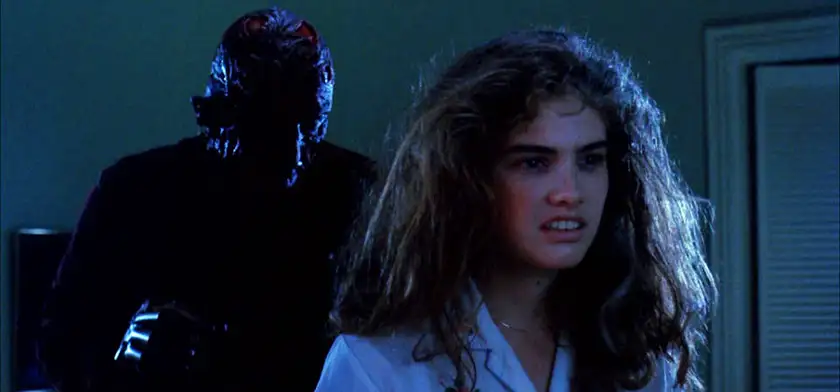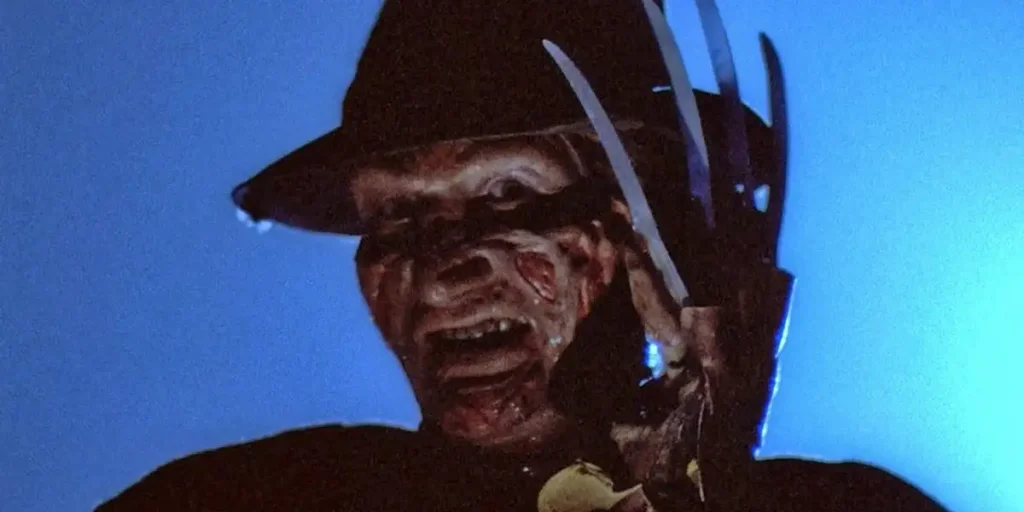Wes Craven’s original A Nightmare on Elm Street (1984) still works as a disturbing and bloody slasher despite its age.
Writer and Director: Wes Craven
Genre: Horror, Slasher
Run Time: 91′
Rated: R
U.S. Release: November 9, 1984
U.K. Release: August 2, 1985
Where to Watch: On digital and on demand, and on DVD & Blu-Ray
A Nightmare on Elm Street wasn’t legendary filmmaker Wes Craven’s first film, but it certainly was the one that made him famous. Not only that, but alongside the Friday the 13th and Halloween franchises, it helped popularise the “slasher” sub-genre of horror cinema in the late 70s and 80s, allowing its (probably teenage) viewers to howl in fear as they watched their favourite killers (supernatural or otherwise) prey on suitably innocent and sometimes idiotic kids.
A Nightmare on Elm Street’s influence on an entire style of filmmaking cannot be overstated.
Nevertheless, sometimes when a viewer decides to watch The First Movie To Ever Do Something™, they might end up feeling a bit disappointed. The innovator, the one film that created a style or genre or type of story, goes on to influence so many later productions, that it can end up feeling rather quaint or boring some years later. It’s a natural occurrence, and of course, it’s not the original movie’s fault. Thankfully, and despite not being as scary nowadays as it was more than forty years ago, I don’t believe this has happened to A Nightmare on Elm Street; at least, not yet. This remains a pretty disturbing and suspenseful production, even if we’ve had literally decades to watch countless copycats and inferior slashers that were clearly inspired by it.
The film takes place in an unnamed town in Ohio, and centres on young Nancy Thompson (Heather Langenkamp), a regular girl who attends the local high school and spends time with her jock boyfriend, Glen (Johnny Depp in his first ever role), her best friend, Tina (Amanda Wyss), and the latter’s sort-of boyfriend, cool guy Rod Lane (Jsu Garcia). Unfortunately, it turns out that all of them except for Glen have been having the same recurring nightmare, waking up in a sweat after dreaming with a mysterious burnt man wearing a striped sweater and metallic, clawed gloves.
One night, as Nancy and Glen are keeping Tina company at her home while her mum is away on a trip, things take a turn for the worse: Rod arrives at the house, and after having sex with Tina, the latter is attacked in her dreams and dies. Rod is obviously blamed for her death and later arrested, but Nancy knows he is innocent. She knows the real culprit is Freddy Krueger, a child killer that died years before, but who now seems to inhabit the world of dreams. Eager to save Glen from a horrible death and incapable of falling asleep, Nancy decides she’s the only one who can find and defeat sadistic Krueger.

The premise of A Nightmare on Elm Street is full of potential, and although not all of Craven’s ideas could be included in this first movie (many of them would later appear in the numerous sequels), the way it’s utilised in order to generate suspense and horror is truly masterful. The fact that Nancy simply cannot fall asleep and has to resort to taking pills and drinking coffee like an addict turns her into a vulnerable protagonist, who gradually becomes more unhinged and desperate as she spends more and more time awake.
Moreover, the rules regarding Krueger’s powers are established quite effectively. In short, he can only attack and kill in the dream world, and although sometimes he can cross the barrier between his nightmares and the real world, he cannot do a lot to people who are awake, and can only appear in our world if brought back by someone else. All of this results in memorable sequences in which Freddy tries to cross to the “awake” world, such as the one in which his face appears beneath a “stretchy” wall in Nancy’s room, or the scene in which his clawed glove emerges from the water in a bathtub, between our protagonist’s legs.
In fact, A Nightmare on Elm Street is full of memorable imagery, which helped turn it into a true classic. Consider, for example, the geyser of blood that shoots from inside a bed when a certain character is killed, or the scene in which Tina is attacked by Krueger, and starts walking and crawling on the walls and ceiling of her mum’s bedroom, defying gravity. A Nightmare on Elm Street was a relatively low-budget affair (a reported 1.8 million dollars, which nowadays is almost nothing), but a lot was done with the resources at hand to craft truly innovative moments of practical horror and suffering.
Nevertheless, the film never overdoes it with the blood and gore, only including a couple of truly bloody kills, which contrasts perfectly with the rest of the relatively low-key affair. A Nightmare on Elm Street is more about the suspense regarding the presence of Krueger, who is usually shown amidst shadows and fog. Is he real or is he not? And when we find out he is, how can Nancy convince the adults –especially his lieutenant father, played by John Saxon– that he is the actual killer of Tina and other characters in town? This is the classic tale of a protagonist who knows the truth, and has to convince the rest of the characters that what she’s saying is real, despite sounding completely unbelievable.
Now, performances are a bit inconsistent, which does affect the movie’s overall effectiveness. Heather Langenkamp is not totally convincing at the beginning of the film, and actually starts giving a more believable performance the moment her character stops sleeping, looking tired and behaving more erratically. In any case, the character itself is quite interesting; a rather stereotypically virginal protagonist (unlike her dead best friend, she refuses to have sex with her boyfriend) who eventually turns into a strong and resourceful young woman, even resorting to installing booby traps at her house for Freddy, Home Alone-style (but six years before the release of Chris Columbus’ Christmas classic).
One can’t talk (or write) about A Nightmare on Elm Street without mentioning Robert Englund, though. There’s a reason why he’s become synonymous with the character of Freddy Krueger. Even though in this film he hasn’t adopted the killer’s snarky, witty persona, he’s suitably chilling as the Lord of the Nightmare World, portraying him as a ruthless demon who likes playing with his victims. He doesn’t have a lot of screentime (about eight or nine minutes, give or take), but it does feel like the movie belongs to him and his iconic look (red and green striped jumper, long claws, well-worn hat). He is a formidable opponent, and is perfectly portrayed by Englund.
On the other hand, the movie’s ending has been a point of contention for years; some viewers enjoy its open-endedness, while others are frustrated by it. I think I’m in the latter group, even though I tend to change my mind whenever I watch the movie again. A more traditional and “happy” ending would certainly have been less memorable, but at the same time, the one we get doesn’t make too much sense, which makes it feel more frustrating than truly satisfying. There are cool elements to it, though – like the striped roof of Glen’s car, or the practical effect of Nancy’s mum getting pulled through the door’s window– but overall, it feels too nonsensical and abrupt to work.
Nevertheless, the ending is not bad enough to ruin the overall experience of watching A Nightmare on Elm Street. Yes, since it’s one of the first movies of its kind, it does include a couple of clichés that feel ridiculous in the Year of Our Lord 2025; namely, the fact that the female character who has sex dies and the virginal one doesn’t, or the adult characters who refuse to believe the teenage ones. That and the ending prevent the film from being a complete success. However, A Nightmare on Elm Street still deserves to be considered a classic; it’s an atmospheric, memorable and suspenseful slasher, full of creative and shocking kills, and featuring one of cinema’s most recognisable villains. It isn’t perfect, but honestly, that doesn’t matter all that much.
A Nightmare on Elm Street: Movie Plot & Recap
Synopsis:
A regular teenage girl must battle against the spirit of a dead child killer, who now resides and kills inside the dreams of whoever stands in his way.
Pros:
- Still occasionally disturbing.
- Freddy Krueger is an icon for the ages.
- Plenty of atmosphere.
- Some creative and bloody kills.
- Excellent practical effects.
Cons:
- Doesn’t feel particularly scary nowadays.
- Performances are inconsistent.
- A rather frustrating ending.
A Nightmare on Elm Street is now available to watch on digital and on demand.
Loud and Clear Reviews has an affiliate partnership with Apple, so we receive a share of the revenue from your purchase or streaming of the films when you click on some of the links on this page. This won’t affect how much you pay for them and helps us keep the site free for everyone.

